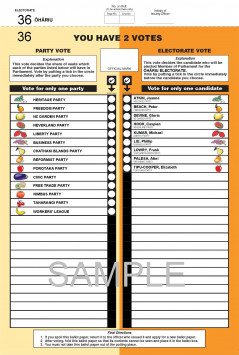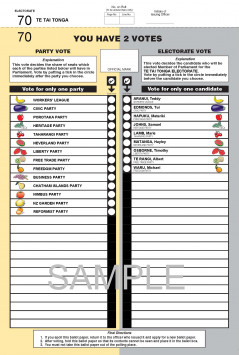The 2023 General Election was held in October.
General elections decide who represents us in government. New Zealand usually has a general election every 3 years.
Voting System
The voting system we use in a general election is called Mixed Member Proportional (MMP).
The general election cycle
General elections follow a 3-year cycle. Rules and timelines guide what happens in each stage of the cycle.
Prime Minister announces election date
Before Parliament’s maximum term of 3-years is over, the Prime Minister (PM) must decide when the next general election will be held.
Once the PM announces the date, the general election cycle starts, following the rules in the Constitution Act 1986 and the Electoral Act 1993.
The PM can call a ‘snap election’ or early election — an election held before the 3-year term is up. However, snap elections aren’t common in New Zealand.
Parliament dissolves and the Governor-General delivers the ‘writ’
At the end of each 3-year term, Parliament dissolves. The Governor-General then gives the chief electoral officer a written notice (a writ) saying that a general election needs to be held. The writ includes the:
- election date
- deadline for nominating candidates
- deadline for returning the writ with the names of the winning candidates.
Candidates are nominated to stand for election
Both electorate and party candidates are nominated during a set period. The deadline is included in the writ.
Electorate candidates can stand for a party or as an independent candidate.
Each registered political party that’s contesting the party vote must send us their party list. A party list ranks candidates in the order the party wants them to get seats in Parliament.
Voting begins
Voting opens around 2 weeks before election day. Many people choose to vote before our official election day — that’s called advance voting. However, voters have until 7pm on election day to vote.
Everyone who is enrolled to vote gets two votes: an electorate vote and a party vote. The electorate vote is for the candidate you want to represent the area you live in (your electorate). The party vote is for the party you want to represent you.


Sample voting papers for the general and Māori electorates.
We publish preliminary results
On election night we publish the preliminary results for each party and electorate candidate. The preliminary results give an early idea of how parties and candidates are doing before the final count is complete.
The chief electoral officer declares the official results
The chief electoral officer declares the official results 2-3 weeks after voting closes. The count process is very thorough and takes time to complete.
Recounts or petitions may be held
For a limited time after an election:
- electorate candidates can apply to a District Court Judge for a recount of the electorate vote
- party secretaries can apply for a recount of the party vote in one or more electorates.
If a Judge approves a recount application, the official recount process begins. We declare the results once the recount is complete.
Election recounts and petitions
The chief electoral officer returns the writ
When the official count is final, the chief electoral officer returns the writ with the names of the winning candidates.
Seats in Parliament are allocated
Every candidate who wins an electorate gets a seat in Parliament.
The remaining seats are filled from party lists according to the share of the party vote each party got.
The political party or group of parties with the most seats becomes the government. Under MMP, one party may not have a large enough share of the votes to govern alone. Parties usually have to negotiate to form a government.
Election cycle ends
The election cycle ends when the newly elected MPs take their seats and Parliament resumes.
